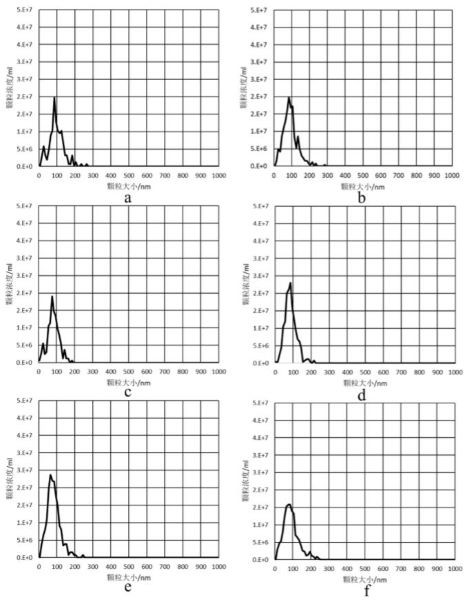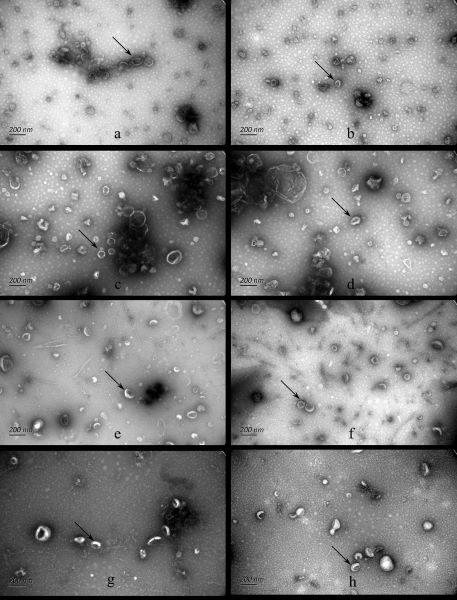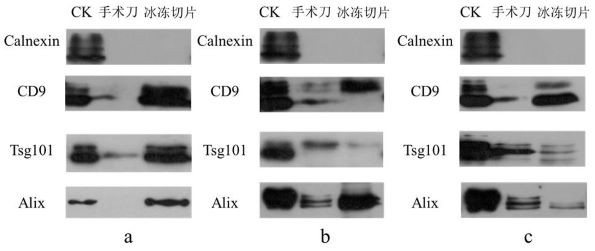Method for increasing tissue exosome yield by using freezing microtome
A technology of frozen sections and exosomes, applied in tissue culture, cell dissociation methods, preparation of test samples, etc., can solve the problems of long time-consuming, cumbersome process, and increased extraction yield, so as to increase the tissue surface area and reduce the dosage , The effect of increasing production
- Summary
- Abstract
- Description
- Claims
- Application Information
AI Technical Summary
Problems solved by technology
Method used
Image
Examples
Embodiment 1
[0044] Example 1 A method of using a frozen microtome to increase the output of exosomes in mouse brain tissue
[0045] A method for extracting mouse brain tissue exosomes using a frozen microtome, the specific steps are as follows:
[0046] (1) Pretreatment before the experiment: Start the cryostat 3 hours in advance to pre-cool, set the temperature of the microtome and the sample head to -25°C, tissue sample 0.2g, embedding box (Nantong Meiweide Experimental Equipment Co., Ltd., article number EM05 -0707) and the sample tray were pre-cooled in dry ice 30 minutes in advance, and the embedding medium was 1×PBS buffer solution and pre-cooled at 4°C 3 hours in advance.
[0047] (2) Tissue sample embedding: The following operations are carried out in dry ice: put the tissue sample into the embedding box and use pre-cooled 1×PBS buffer solution for embedding, so that the 1×PBS buffer solution is completely submerged in the tissue After the tissue is embedded in PBS, apply a layer...
Embodiment 2
[0069] Example 2 A method of using a frozen microtome to increase the production of exosomes in mouse spleen tissue
[0070] This example provides a method for extracting exosomes from mouse spleen tissue using a cryostat, and the specific steps are as follows:
[0071] (1) Pretreatment before the experiment: start the cryostat 3 hours in advance to pre-cool, set the temperature of the microtome and the sample head to -20°C, pre-cool the tissue samples, embedding boxes and sample trays in dry ice 30 minutes in advance, and pre-cool the embedding agent 3 hours in advance Pre-cool at 4°C.
[0072](2) Tissue sample embedding: Put the tissue sample into the embedding box and use pre-cooled 1×PBS buffer for embedding, so that the 1×PBS buffer is completely submerged in the tissue, and wait for the 1×PBS buffer to wrap. After burying the tissue, apply a layer of 1×PBS buffer solution on the sample tray with a thickness of about 3mm, and quickly transfer the tissue embedded in the e...
Embodiment 3
[0090] Example 3 A method of using a frozen microtome to increase the yield of exosomes in mouse gastric tissue
[0091] This example provides a method for extracting mouse gastric tissue exosomes using a cryostat, the specific steps are as follows:
[0092] (1) Pretreatment before the experiment: start the cryostat 3 hours in advance to pre-cool, set the temperature of the microtome and the sample head to -20°C, pre-cool the tissue samples, embedding boxes and sample trays in dry ice 30 minutes in advance, and pre-cool the embedding agent 3 hours in advance. h Pre-cool at 4°C.
[0093] (2) Tissue sample embedding: Put the tissue sample into the embedding box and use pre-cooled 1×PBS buffer for embedding, so that the 1×PBS buffer is completely submerged in the tissue, and wait for the 1×PBS buffer to wrap. After burying the tissue, apply a layer of 1×PBS buffer on the sample tray with a thickness of about 2mm. When the 1×PBS buffer on the tray turns white, quickly transfer th...
PUM
 Login to View More
Login to View More Abstract
Description
Claims
Application Information
 Login to View More
Login to View More - R&D
- Intellectual Property
- Life Sciences
- Materials
- Tech Scout
- Unparalleled Data Quality
- Higher Quality Content
- 60% Fewer Hallucinations
Browse by: Latest US Patents, China's latest patents, Technical Efficacy Thesaurus, Application Domain, Technology Topic, Popular Technical Reports.
© 2025 PatSnap. All rights reserved.Legal|Privacy policy|Modern Slavery Act Transparency Statement|Sitemap|About US| Contact US: help@patsnap.com



